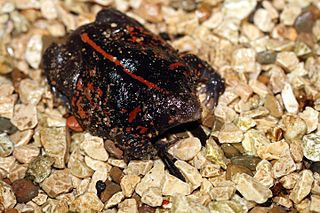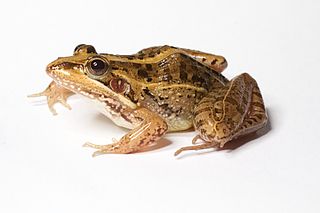
Amphibians are four-limbed and ectothermic vertebrates of the class Amphibia. All living amphibians belong to the group Lissamphibia. They inhabit a wide variety of habitats, with most species living within terrestrial, fossorial, arboreal or freshwater aquatic ecosystems. Thus amphibians typically start out as larvae living in water, but some species have developed behavioural adaptations to bypass this.

A frog is any member of a diverse and largely carnivorous group of short-bodied, tailless amphibians composing the order Anura. The oldest fossil "proto-frog" Triadobatrachus is known from the Early Triassic of Madagascar, but molecular clock dating suggests their split from other amphibians may extend further back to the Permian, 265 million years ago. Frogs are widely distributed, ranging from the tropics to subarctic regions, but the greatest concentration of species diversity is in tropical rainforest. Frogs account for around 88% of extant amphibian species. They are also one of the five most diverse vertebrate orders. Warty frog species tend to be called toads, but the distinction between frogs and toads is informal, not from taxonomy or evolutionary history.

The Mexican burrowing toad is the single living representative of the family Rhinophrynidae. It is a unique species in its taxonomy and morphology, with special adaptations to assist them in digging burrows where they spend most of their time. These adaptations include a small pointed snout and face, keratinized structures and a lack of webbing on front limbs, and specialized tongue morphology to assist in feeding on ants and termites underground. The body is nearly equal in width and length. It is a dark brown to black color with a red-orange stripe on its back along with splotches of color on its body. The generic name Rhinophrynus means 'nose-toad', from rhino- (ῥῑνο-), the combining form of the Ancient Greek rhis and phrunē.

Probreviceps is a small genus of brevicipitine frogs with only six members. They occur in the montane forests of Tanzania, Zimbabwe, and possibly Mozambique. They are sometimes known as the forest frogs, forest rain frogs, big-fingered frogs, or primitive rain frogs.

Conraua, known as slippery frogs or giant frogs is a genus of large frogs from sub-Saharan Africa. Conraua is the only genus in the family Conrauidae. Alternatively, it may be placed in the family Petropedetidae.

The rough frog, also known as the woodland water-holding frog, warty water-holding frog, and red-backed cyclorana, is a species of treefrog native to northern New South Wales and south-eastern Queensland, Australia.

Phrynobatrachus is a genus of Sub-Saharan frogs that form the monogeneric family Phrynobatrachidae. Their common name is puddle frogs, dwarf puddle frogs, African puddle frogs, or African river frogs. The common name, puddle frog, refers to the fact that many species breed in temporary waterbodies such as puddles.

The Petropedetidae are a family of frogs containing three genera and 12 species. They are found in sub-Saharan tropical Africa and are sometimes known under common name African torrent frogs.
Phrynobatrachus steindachneri is a species of frog in the family Phrynobatrachidae. It is found in western Cameroon and eastern Nigeria. The specific name steindachneri honours Franz Steindachner, an Austrian herpetologist and ichthyologist. This species is also known as Steindachner's puddle frog and Steindachner's river frog.
Conraua robusta, the robust giant frog or Cameroon slippery frog, is a species of frog in the family Conrauidae found in western Cameroon and eastern Nigeria. This species is congeneric to the goliath frog, the largest known frog species in the world.

Hildebrandtia macrotympanum is a species of frog in the family Ptychadenidae. It is a rarely seen fossorial frog that is found in southern Ethiopia, Kenya, and Somalia. Common names Somali ornate frog, northern ornate frog, and plain burrowing frog have been proposed for it.
Ptychadena guibei is a species of frog in the family Ptychadenidae. It is found in northeastern and eastern Angola, the Caprivi Strip of northeastern Namibia, northern Botswana, northwestern and eastern Zimbabwe, Zambia, southern Democratic Republic of the Congo, Malawi, and northern Mozambique. The specific name guibei honours Jean Guibé, a French zoologist and herpetologist. Common names Guibe's yellow-bellied grass frog, Guibe's grass frog, Guibe's grassland frog, and Guibe's ridge frog have been coined for it.
Ptychadena perreti is a species of frog in the family Ptychadenidae. It is found in Cameroon, Gabon, Republic of the Congo, southwestern Central African Republic and northern Democratic Republic of the Congo. It might occur in the Cabinda enclave of Angola and mainland Equatorial Guinea. Common name Perret's grassland frog has been coined for it.
Ptychadena submascareniensis is a species of frog in the family Ptychadenidae. This West African frog is found on the Nimba Range of Ivory Coast, Guinea, and Liberia, and on the Loma Mountains of Sierra Leone.
Ptychadena tournieri is a species of frog in the family Ptychadenidae. It is a widespread species in West Africa and found in Senegal, Gambia, Guinea-Bissau, Guinea, Sierra Leone, Liberia, and Ivory Coast, as well as in Togo and Benin; it is assumed to occur in Ghana and southeastern Burkina Faso, although it has not been recorded there. On the other hand, some records may refer to other species; the Amphibian Species of the World excludes Gambia and Togo from the distribution. Common names Liberia grassland frog and Tournier's rocket frog are sometimes used.

Ptychadenidae is a family of frogs commonly known as the grassland frogs. These frogs occur in Sub-Saharan Africa.
Johann Maria Hildebrandt was a German explorer, collector, and scientist.
Fritz Nieden was a German zoologist who specialized in African herpetology.










